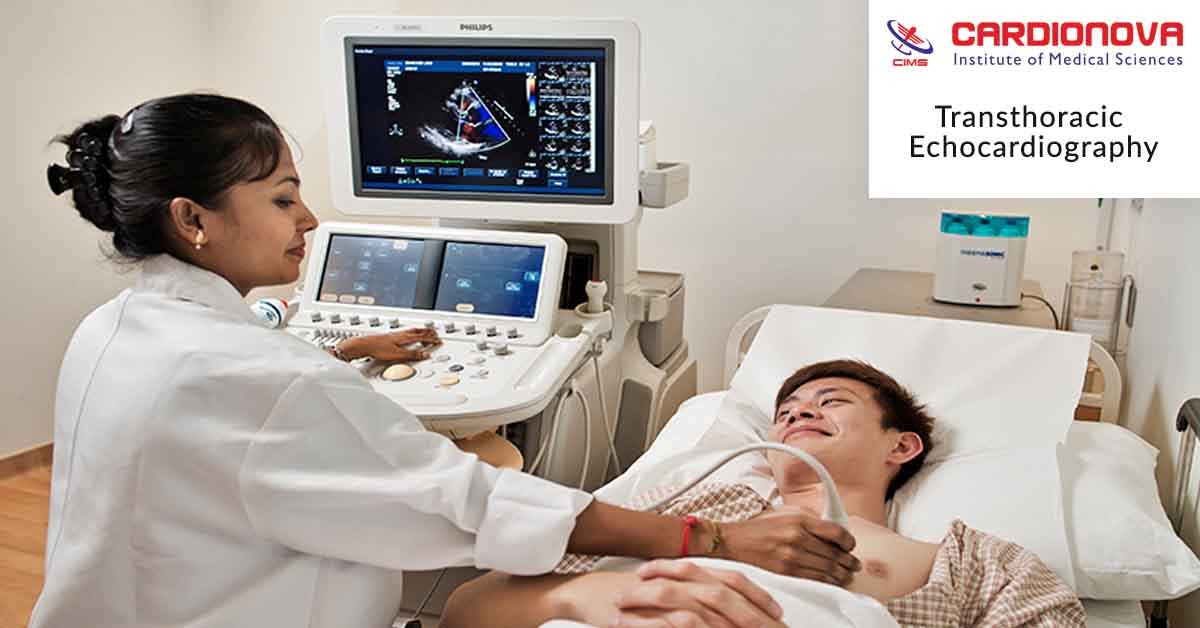
CARDIONOVA offers advanced cardiac care and state of the art technologies with a highly skilled cardiac team that assembles in minutes to treat heart attacks and other cardiac emergencies.
Read More
Echocardiography uses sound waves to visualise the heart structures. Ultrasound waves are high-frequency sound waves undetectable to human ears. In transthoracic echocardiography (TTE), ultrasound waves are transmitted from a probe or transducer placed on the chest wall into the chest cavity. The sound waves are reflected from the heart and other organs in the chest, and the reflected waves (echoes) are received by the same transducer. These echoes are then converted into electrical signals that are processed by computers to form two-dimensional images of the moving heart. The images are displayed on a video monitor
TTE is a non-invasive test as no part of the instrument is inserted into the body.
What is the purpose of this test?
TTE is one of the most commonly performed tests in modern-day cardiology practice. It allows detailed visualisation of the heart chambers and the great vessels in the chest. It is also used to examinetheflowofbloodthroughthesestructures. It can reveal abnormalities of the heart valves and muscles. One of the most important uses of the TTE is to determine how well the heart functions as a pump. It is also an important tool in diagnosing congenital heart diseases, such as hole-in-the-heart.
What can I expect?
1.There is no need to fast or take pre-medication before the procedure.
2.Throughout the examination, which takes about 30-45 minutes, you will be lying mostly on your left side. You may be asked to hold your breath periodically.
3.Before the examination, your height, weight and blood pressure will be recorded.
4.Three electrocardiogram (ECG) leads will be placed on your chest to track your heart rhythm. A water-soluble gel is applied to your chest wall, upper abdomen, or neck, to provide an air-free contact for the transducer. Your technologist will apply the transducer to these areas to obtain the best possible images of your heart, which will be displayed on a video monitor.
5.To view these images clearly, the lights in the examination room need to be dimmed.
6.Blood flow through the heart structures may be amplified and heard as swishing sounds corresponding to the heartbeat. Do not be alarmed by these sounds.
7.After the examination, the technologist will help clean up the gel, which can be easily wiped or washed off.
What should I do before the test?
No special preparation is required. However, to facilitate the examination of the heart from the upper abdomen, it may be helpful to avoid eating, or taking fizzy drinks, about two hours before the test.
What are the potential risks/complications with this test?
Ultrasound is extremely safe. No clinically important adverse effects have been reported, even with repeated examinations. Pregnant women may also undergo TTE, without additional risk to themselves or the unborn child. Sometimes, pressure of the transducer on the chest wall may cause some discomfort. Please inform the technologist if you experience any discomfort.
When will I know the results?
The supervising doctor will review the TTE imagesanddataaftertheexamination.Occasionally, he or she may need to obtain further images of the heart after the initial scan by the technologist. A formal report should be available in 4hours. Your doctor will inform you of these results, usually at your clinic visit. However, you may be contacted earlier if there isasevereabnormalityrequiringurgentattention.
Contact information & further questions!
If you have any questions or concerns about your Transthoracic Echocardiography Test or further treatment, please do not hesitate to contact us.
© 2018 Cardionova. Privacy Policy | All rights reserved Designed & Developed By Three Dots Media Pvt. Ltd